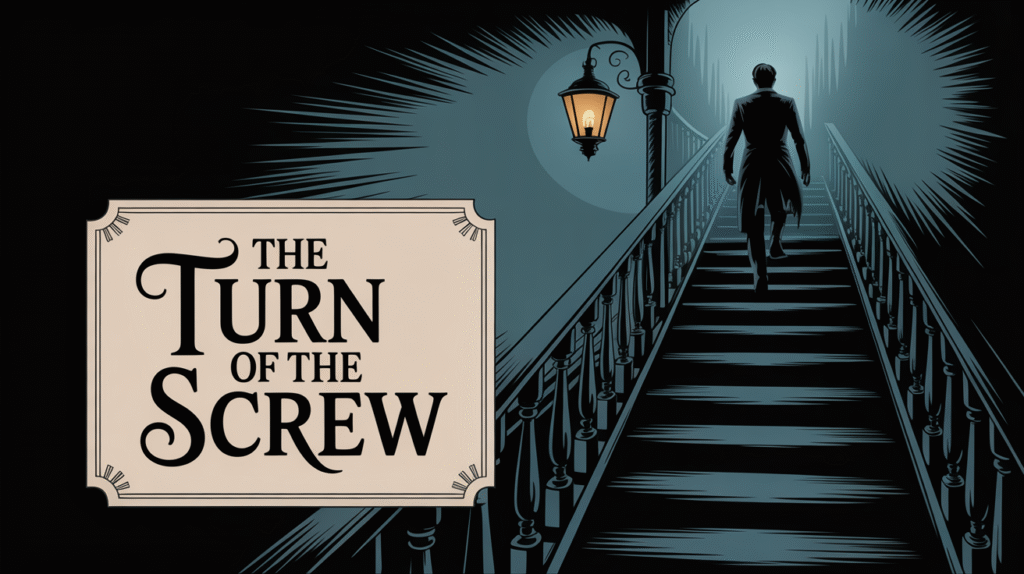The narrative style and point of view in “The Turn of the Screw” are designed to manipulate the reader’s trust, fueling the story’s haunting ambiguity.

Henry James’s The Turn of the Screw is renowned not just for its eerie plot but for the deliberate way it is told. The narrative structure is layered and complex, forcing the reader to question what is true. By using a frame narrative, an unreliable first-person narrator, and stylistic flourishes that emphasize ambiguity, James ensures that the story’s horror resides as much in the telling as in the events themselves.
Frame Narrative – A Story Within a Story
The novella opens with a framing device: a group of people gathered around a fire, listening to a manuscript read aloud.
Why the Frame Matters
This outer layer distances the reader from the actual events, adding a layer of uncertainty.
- We’re not hearing the story directly—we’re reading a manuscript supposedly written by the governess.
- The narrator who introduces the manuscript (Douglas) claims to know her personally, but we never meet her ourselves.
Emotional Setup and Suspense
The frame also establishes mood and prepares the reader for suspense.
- Douglas hints at the governess’s bravery and the story’s darkness before it even begins.
- This primes the reader to question her reliability and anticipate psychological complexity.
First-Person POV – The Governess’s Eyes Shape Everything
Once the manuscript begins, the story unfolds entirely from the governess’s first-person perspective.
Subjective Experience
We see only what the governess sees—and what she chooses to tell us.
- This limits the information available to the reader.
- Her emotions, perceptions, and interpretations are our only guide through the narrative.
Bias and Filtering
Her narration is colored by fear, desire, and isolation.
- She may be interpreting events through a lens of growing paranoia.
- Her selective memory and dramatic reactions suggest she may not be a neutral observer.
Ambiguous Language – Style That Evades Certainty
James’s writing style in the novella is intentionally vague, leaving room for multiple interpretations.
Euphemism and Suggestion
Key events and emotions are hinted at rather than described clearly.
- The children’s misdeeds, for example, are never stated outright.
- Sexual and psychological undercurrents are implied through indirect language.
Complex Sentences and Psychological Depth
The sentence structure reflects the governess’s anxious and spiraling mindset.
- Long, winding sentences mirror her mental state.
- Repetition and vague transitions suggest confusion and emotional instability.
Tension Through Incompleteness
James uses gaps in narration to build suspense and keep the reader guessing.
Unreliable Gaps
Critical moments often happen “offscreen” or are described after the fact.
- Flora’s illness, Miles’s school expulsion, and even the ghosts’ appearances are recounted rather than witnessed with certainty.
- The reader is left to connect the dots, but those dots may be false or misleading.
Sudden Shifts and Withheld Information
The governess often shifts tone or drops major revelations abruptly.
- This unpredictability makes it harder to assess her mental state.
- It also mimics the way trauma and repression affect memory and storytelling.
The Reader’s Role in the Narrative
James forces readers to become active participants in constructing the story’s meaning.
Forced Interpretation
Because the narration is so subjective, readers must choose what they believe.
- Are the ghosts real or imagined?
- Are the children corrupted, or is the governess projecting her fears?
Engagement Through Doubt
Uncertainty keeps readers engaged long after the story ends.
- Each reading can offer a different interpretation.
- The narrative style ensures no two readers experience the story in the same way.
FAQs About Narrative Style & POV in The Turn of the Screw
Here are some questions and answers about the narrative technique used in The Turn of the Screw:
Why did Henry James use a frame narrative?
The frame narrative adds a layer of distance and doubt, making the story feel like an old legend rather than a factual account. It also enhances suspense by shaping expectations before the real story begins.
Is the governess a reliable narrator?
Most scholars argue she is not. Her subjectivity, emotional instability, and dramatic storytelling suggest she may be misinterpreting or even fabricating events.
How does first-person POV impact the story?
It immerses the reader directly in the governess’s experience but also traps them in her limited, potentially flawed perspective.
Why is the language so vague and indirect?
James uses ambiguous language to maintain suspense and to reflect the psychological complexity of the characters. This indirectness encourages multiple interpretations.
How does the narrative style affect the reader?
It creates a sense of unease and forces active interpretation, making the reader a participant in the mystery rather than a passive observer.
In The Turn of the Screw, the story isn’t just about ghosts—it’s about how stories are told. James’s careful use of narrative structure and point of view turns the act of reading into an unsettling experience, one where the truth remains forever just out of reach. That’s why the novella continues to captivate and confuse more than a century after it was first published.
